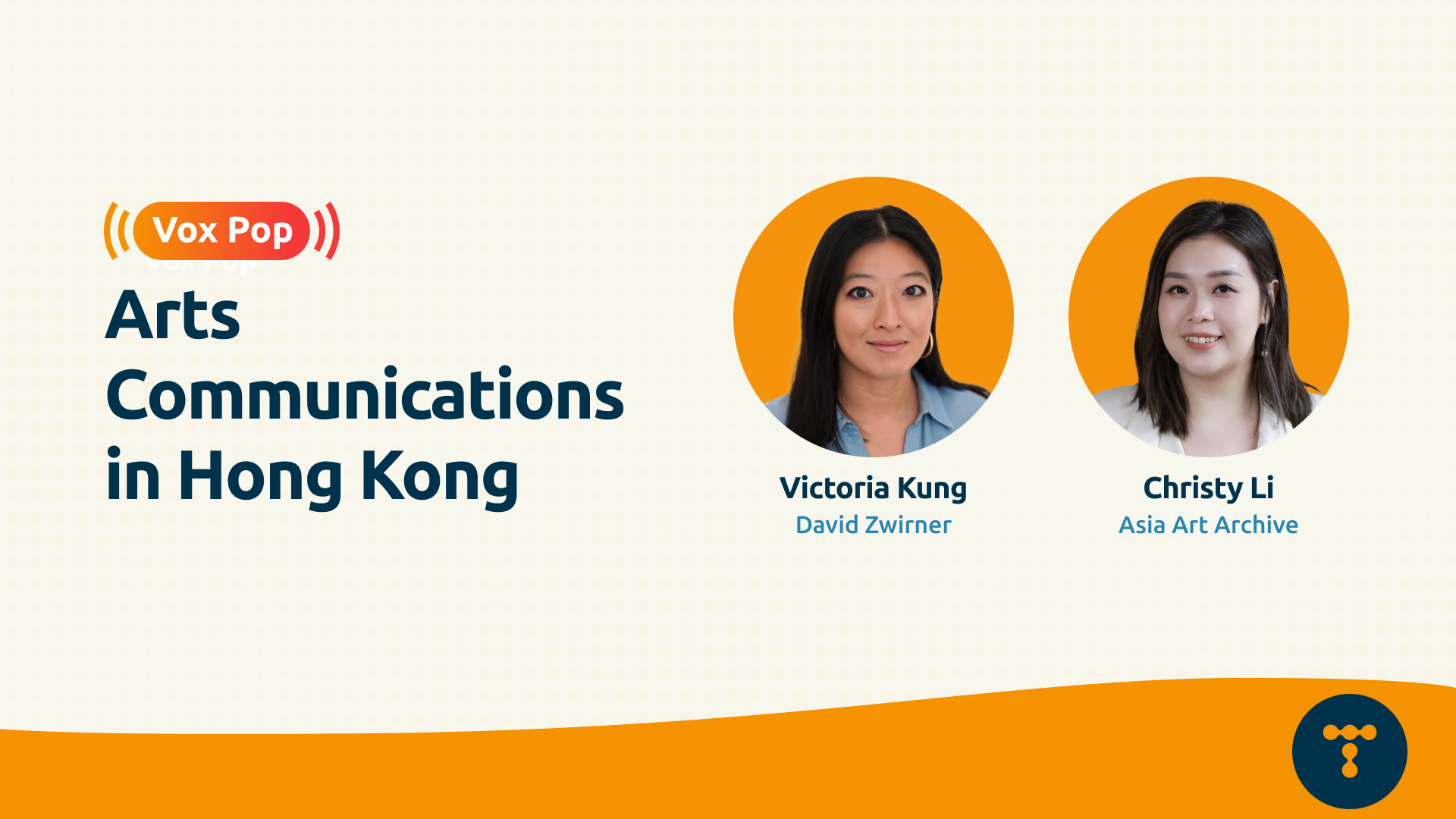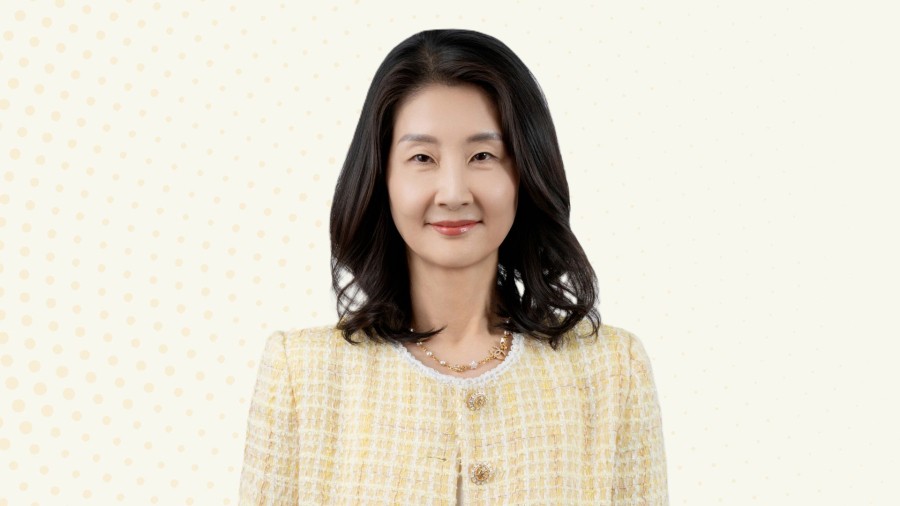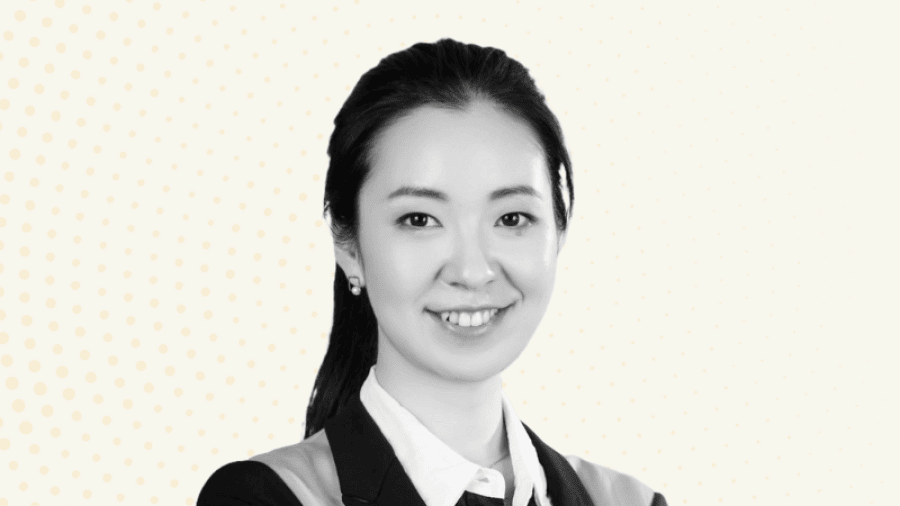March in Hong Kong shines the spotlight on the city's artistic and creative side. In celebration of this Hong Kong Arts Month, Telum spoke with communicators engaged in Hong Kong's arts industry to hear about building reputation
within subjective narratives and how communications can help further drive Hong Kong's standing as an art capital.
What are the challenges to building reputation, trust and brand awareness in the art world?
Christy Li, Head of Communications, Asia Art Archive
One significant challenge we face is the rich diversity of art and the varying levels of understanding amongst different audience segments. Audiences engage with art in distinct ways, which necessitates tailored communications strategies to ensure that our targeted communities feel connected to the art narrative.
It is important to maintain consistency in branding while implementing diverse approaches to audience engagement. At Asia Art Archive (AAA), we are dedicated to documenting contemporary art history in Asia and disseminating knowledge, and actively prioritise accuracy, objectivity, and professionalism across our content. As a result, our communications strategy will provide multiple entry points for audiences to explore our archive - whether through long-form writing for art professionals or engaging social media posts for broader audiences.
Through considering the variations in language, themes, and visuals across platforms, we are better positioned to address the challenges of communicating in this industry, thereby fostering more inclusive dialogue around art. This approach not only enhances our brand but also builds trust and credibility within the diverse art community that we serve.
Victoria Kung, Associate Director, Marketing and Communications, David Zwirner
The art world is often perceived as being inaccessible, whether in terms of understanding its concepts or even physically entering museums and gallery spaces. As such, while continuing to develop diverse strategies to maintain relationships with the traditional art crowd and media, we have to also consider tailoring campaigns to reach new and curious audiences that are increasingly interested in art and culture.
The opportunities today to reach beyond experienced collectors to appeal to new culture-hungry audiences are wide-ranging, especially as the art world increasingly overlaps with other sectors, from fashion and film to sport and technology. This is an exciting area where the art world can break out of the ‘white cube’ and reassert its relevance in everyday life.
While it may take more time and effort for the public to gain a stronger affinity to different artists and creative concepts, this effort may ultimately lead to longer and more meaningful relationship building with our growing audiences and potential clients.
Is there a different approach to doing PR in the arts industry?
Christy: There is indeed a distinct approach to doing PR in the arts industry, which is driven by the unique nature of art and its audiences.
Storytelling is key to public and media engagement, where narratives and affects are just as important as the visual content. At AAA, our comms focus is on crafting compelling stories that resonate with diverse audiences. For example, when promoting an exhibition, we highlight not just the artwork but also the artists' journeys, artistic processes, as well as cultural and social contexts to invite deeper connections from the audience.
We also adapt our pitch angles and language to suit different media outlets. Engaging with art and cultural media requires a nuanced approach, as these platforms often seek historical context and insightful commentary. As a resource for the history of contemporary artists and artworks, AAA is positioned as a source that provides the background information valued in art and cultural media coverage.
How have your arts communications evolved to account for Gen Z's and their tastes?
Victoria: Younger generations have demonstrated a keen and growing interest in the arts. Digital platforms and social media have made it easier for people to learn and directly follow artists and art spaces that they are interested in. Art galleries and organisations can effectively utilise these tools to bring audiences behind the scenes and into spaces such as the artist’s studio, which can help extend and augment the physical experience of being in an exhibition.
Art provides a wealth of narratives that can be shared through more traditional formats, like books and artist talks, as well as through digital media, like videos and podcasts. Whether online or offline, it is important to adapt your message to different cultural demographics while maintaining a cohesive brand identity and an authentic voice. Even across social media platforms, like Instagram, WeChat and Little Red Book, communications content should be tailored towards the platform’s native users and the brand’s targeted audience.
How can PR help drive the development and reputation of Hong Kong as an art capital?
Christy: PR plays a vital role in enhancing Hong Kong's reputation as an art capital, especially as awareness of contemporary art continues to grow. Events like Arts Month and Art Basel, alongside the emergence of cultural institutions such as M+, Tai Kwun, and the Palace Museum, have significantly increased public interest.
AAA aims to provide different lenses and perspectives on art that contribute to a balanced art ecology. By highlighting less visible artists, art organisations, and narratives across Asia, we can broaden the dialogue and foster a more inclusive art scene. This not only enhances the visibility of diverse voices but also positions Hong Kong as a dynamic hub for contemporary art, attracting both local and international audiences.
Victoria: The arts scene in Hong Kong has been a cornerstone of the city’s cultural appeal for years now, and with institutions such as M+ and Tai Kwun, alongside the new local and international galleries opening up, there is a uniquely rich diversity of art that should be celebrated. At any given time, visitors can expect to see the works of important historical artists and emerging experimental voices on view.
Hong Kong is also a critical hub for the wider Asian art scene, from which gallerists, curators, writers, and artists frequently travel in and out of. This kind of movement and exchange is leverage that continues to help Hong Kong cement its position in the art world as a primary hub, as well as a critical gateway, between Asia and the West.

Feature
Telum Vox Pop: Arts Communications in Hong Kong
by Telum Media
31 March 2025 4:15 PM
6 mins read
Telum Media creating connections
Get in touch to learn more
You might also enjoy
Feature
Over the past few years, mentions of AI within the industry haven't toned down - if anything, they've been ramping up. Looking back at Telum's 2024 Year Ahead and PR Tech in 2025 pieces, it's interesting to see how attitudes have shifted. What began as a period of experimentation - playing with prompts, dabbling in ideation, and speculating about job replacement - has solidified into a structural transformation within the profession.
AI has moved from a nice-to-have to a non-negotiable; from a fringe tool to a core strategic capability. 2025 is the year PR and comms practitioners stopped asking, “What can AI do?” and began asking, "How do we lead with it?”.
Integration of AI tools in the industry
Early adoption of AI centred around basic prompting and inspiration. In 2025, however, practitioners in the PR and comms space have unlocked more of its capabilities.
We saw many organisations develop their own AI offerings across APAC and the Middle East, ranging from AI visibility services and training tools to crisis solutions. These include PIABO GEO, Ogilvy ANZ’s Generative Impact, Golin’s First Answer, TEAM LEWIS' Training for Trust, and FINN Partners' CANARY FOR CRISIS.
The narrative around job replacement has also softened. Rather than replacing humans, the industry is now embracing AI as an enhancer.
As Natacha Clarac, Director General of Athenora Consulting in Brussels and former President of PRGN, said following PRGN's launch of Précis Public Relations: "The introduction of Précis Public Relations showcases the potential of AI to enhance rather than replace the strategic value PR professionals offer."
GEO / LEO and search transformation
One trend that we have seen in 2025 was the decline of traditional search behaviour. AI assistants, such as ChatGPT, Gemini, and Perplexity, increasingly replaced clicks with instant answers.
As Nichole Provatas, Executive Vice President and APAC Head of Integrated Marketing and Innovation at WE Communications, noted: "Around 69 per cent of Google news searches now end in zero clicks as AI Overviews rise."
This reality raises the stakes for inclusion in AI answers, as Rob van Alphen, Managing Director of Polaris Digital, warned: “…if your brand or leadership isn’t part of the AI answer, you’re invisible.”
Jack Barbour, EVP and AI Lead at Golin New York, and Nichole both highlighted how earned media is key in making brands discoverable, with at least 90 per cent of AI search results coming from earned citations. Brian Buchwald, Edelman’s President, Global Transformation and Performance, emphasised the same point: "You can't buy your way to the top of an AI-generated answer...brands must proactively shape how they appear in LLM outputs or risk being misrepresented, misunderstood, or missed entirely."
AI platforms are relying on reputable journalism, corporate blogs, and expert commentaries - flipping the paid-dominated marketing playbook on its head.
This shift fuelled the rise of GEO (Generative Engine Optimisation) and LEO (Language Engine Optimisation). In April, Celia Harding launched what she described as the world’s first LEO advisory firm, arguing: "While other agencies are looking at how AI can drive efficiencies in creativity and client service, they are all overlooking the real opportunity that lies ahead - shaping the data LLMs learn from."
If SEO defined the 2010s, GEO and LEO are shaping 2025 and beyond, with earned media at the core.
AI upskilling
As AI adoption surged throughout the year, professional development opportunities expanded rapidly, ranging from hands-on workshops and panel discussions to large-scale conferences.
These events spanned the region, including the Generative AI Bootcamp series by PRCA APAC and Sequencr AI, PRCA Thailand's first-ever conference in Bangkok on AI and communications, and Jakarta's “Shape the Future of Your Communications Strategy with AI” workshop hosted by ACE, APPRI and Reputasia Strategic Communications.
Telum Media also hosted its own list of AI-focused events, including workshops with Shaun Davies in Sydney and Melbourne, a workshop with Rob Van Alphen in Singapore, a global webinar with Matt Collette, collaborations with the Kennedy Foundation for panels on AI and journalism in Australia, and joint sessions with SOPA on ethical AI use in publishing in Singapore and Hong Kong.
The scale of these events showed one thing - these sessions were no longer “optional extras”, they've become essential for teams wanting to keep pace with AI's evolution across the industry.
Human and ethical considerations
As AI adoption rose, so did the reminders that human oversight remains essential. Practitioners repeatedly stressed that AI cannot replace human judgement, empathy, or lived experience.
As Matt Cram, Head of Media and Communications at Orygen, put it: "AI can’t replace the way people connect through empathy, creativity, and lived experiences."
Rob van Alphen reinforced this: "…we must double down on our inherently human strengths, such as empathy, curiosity, ethical decision-making, and critical thinking."
And Zeno’s Head of Regional Business Development, Asia, Ekta Thomas, said: "People connect with people - not algorithms."
These sentiments were reinforced across industry events focused on responsible AI use. At the Jakarta workshop, Reputasia Co-Founder and Communications Strategist, Fardila Astari, emphasised the importance of ethical guidelines for AI use, noting that careless application can create reputational risks, as seen in cases where major companies faced credibility issues due to AI-generated inaccuracies.
Similar points were made at Telum Media and SOPA's sessions in Singapore and Hong Kong, where newsroom leaders stressed the importance of maintaining editorial oversight, transparent disclosure, and strong governance structures. The consensus is that while AI may accelerate workflows, humans safeguard credibility.
2026 and beyond
As we approach the new year, AI is shifting from experimental to foundational. Nichole Provatas urges teams to "publish for AI inclusion," treating owned channels as structured, plain-language reference hubs built for machine ingestion.
But the landscape is still evolving, as Matt Cram cautions: "AI doesn’t just surface information, it consumes it…and the best strategies today might look very different tomorrow." For communicators, adaptability becomes the differentiator.
Ultimately, the future isn't AI-led but AI-enabled. As Matt Collette notes, "Human + AI is the new paradigm." Success will come from pairing AI's scale and precision with the empathy, judgement, and contextual understanding only humans can bring.
25 November 2025 2:01 AM
6 mins read
Moves
Burson has named HS Chung as CEO, Asia Pacific, effective 1st December 2025.
HS has been leading the agency’s business in North Asia Pacific across Mainland China, Hong Kong, Japan, and South Korea, and will now oversee the entire APAC region, including Australia, New Zealand, India, Indonesia, Malaysia, Singapore, and Thailand. She remains based in Seoul for the appointment.
“HS has a combination of superpowers that make her very well-suited to lead the entire region,” said Corey duBrowa, Global CEO, Burson. “She is a trusted and sought after CEO and C-suite advisor, a business builder, a talent advocate and an operational maven. These skills, together with her deep understanding of the cultural nuances across and between the markets, will enable Burson to continue delivering exceptional results for our clients and further build on our strong foundation across our Asia-Pacific footprint.”
HS has counselled C-suites from blue-chip multinational organisations across the F&B, electronics, personal care, automotive, and healthcare industries. She also spearheads specialised service offerings for the Korean government and has been involved in government projects, including the Olympics. Prior to Burson, HS founded Synergy Communications in 2000, which became part of Hill & Knowlton in 2002. She previously served as President, Asia at Hill & Knowlton.
“It’s an honor to lead the Asia Pacific region as CEO,” HS remarked. “We have strong momentum across the business and will continue to turn it into results through disciplined focus and execution.
“As our clients navigate unprecedented complexity, we are using our comprehensive AI capabilities and our exceptional talent bench to help businesses make decisions with clarity so they can succeed today and in the future. With Asia-Pacific continuing to grow and shape the global economy, I’m excited to help our clients and teams seize the opportunities that lie ahead.”
Additionally, Adrian Warr, who had been leading South Asia Pacific for Burson, is leaving the region to return to the UK and will depart the business as of 30th November 2025.
Corey said, “I’d like to extend my thanks to Adrian for his contributions to Burson during his time with us, for his leadership in driving our business in South Asia Pacific and his partnership with HS and our leadership team. I wish him the very best in his future endeavors.”
25 November 2025 1:54 AM
2 mins read
Moves
The Sandpiper Group has appointed Estelle Xue as Director in Shanghai. In this new role, she is responsible for leading the office's growth in strategic communications, issues and crisis counsel, and reputation advisory for Chinese companies going global, as well as multinational and domestic clients navigating the Chinese business landscape.
This appointment also sees Estelle managing the office’s strategic development and senior client advisory capability advancement to support Sandpiper's expansion in Mainland China. Furthermore, she is to work closely with the firm's leadership and teams across Asia Pacific and the Middle East to build out the financial comms and special situations advisory offering.
With 15 years of media, law, and corp comms experience, Estelle has advised clients through market transitions, regulatory challenges, and corporate events. With experience working alongside senior executives across industries, she specialises in corporate communications, financial and transactional communications, restructurings, compliance matters, and crisis situations.
Emma Smith, Chief Executive Officer of Sandpiper, said, “Shanghai is an essential market for our clients, and Estelle brings a combination of strategic insight, financial communications experience, and crisis and issues expertise to accelerate the development of our team and capabilities on the ground. Her leadership will be central to strengthening our presence in mainland China and enhancing the support we provide across our regional network.”
On her appointment, Estelle commented, “I am excited to join Sandpiper at a time of such strong momentum across the region. Businesses are facing unprecedented opportunities and challenges, requiring trusted advisors with both a global perspective and deep local knowledge. I look forward to partnering with our talented team to further expand our Shanghai presence and support clients as they manage reputation, risk, and transformation.”
25 November 2025 1:14 AM
2 mins read


